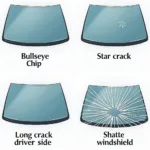A faulty car window mechanism can be a major inconvenience. Whether it’s a slow-rolling window, a jarring grinding noise, or a window that’s completely stuck, the issue needs addressing. This comprehensive guide delves into the intricacies of window mechanism repair, empowering you with the knowledge to understand and potentially resolve common problems.
Understanding the Car Window Mechanism
Before diving into repairs, it’s crucial to understand how the system works. A car window mechanism is a complex assembly of parts working together to raise and lower your windows.
Here’s a simplified breakdown:
- Window Regulator: This is the heart of the system, responsible for lifting and lowering the window glass. There are two main types: cable regulators (using cables to move the glass) and scissor regulators (employing a scissor-like mechanism).
- Window Motor: This electric motor provides the power to the regulator.
- Window Switches: These are the buttons or levers you use to control the window motor.
- Window Tracks and Seals: These guide the window glass and ensure a snug fit to prevent wind and noise.
Common Window Mechanism Problems and Causes
A variety of issues can arise with your car’s window mechanism. Here are some of the most frequent complaints:
- Window Won’t Roll Up or Down: This could indicate a problem with the window motor, regulator, a blown fuse, or a faulty window switch.
- Slow Window Movement: Worn-out window regulator parts, such as frayed cables or bent scissor arms, can cause sluggish movement.
- Grinding or Clicking Noises: These sounds often point to damaged or misaligned regulator components or a lack of lubrication.
- Window Tilts When Rolling Up: This issue typically arises from worn or broken window regulator clips or guides.
- Window Falls Into Door: A broken regulator or a detached cable can cause the window to fall freely into the door panel.
Diagnosing the Problem
Accurately diagnosing the root cause of your window problem is key to effective repair. Here’s a step-by-step guide:
- Listen Carefully: Pay attention to any unusual noises coming from the door when operating the window.
- Inspect the Window Switch: Ensure the switch is functioning correctly. You may need a multimeter to test for electrical continuity.
- Check the Fuse: Locate the window motor fuse in your car’s fuse box and check if it’s blown.
- Examine the Window Regulator: If possible, visually inspect the regulator for any signs of damage, wear, or loose components.
DIY vs. Professional Repair
Some window mechanism repairs are straightforward enough for DIY enthusiasts, while others require specialized tools and expertise.
DIY-Friendly Repairs:
- Replacing window switches
- Checking and replacing fuses
- Lubricating window tracks
Repairs Best Left to Professionals:
- Replacing window regulators
- Repairing or replacing window motors
- Addressing complex electrical issues
Window Mechanism Repair Cost
The cost of window mechanism repair varies greatly depending on the make and model of your car, the severity of the problem, and labor costs in your area.
Here’s a general idea:
- Window Regulator Replacement: $150 – $400
- Window Motor Replacement: $100 – $300
- Window Switch Replacement: $50 – $150
Keep in mind that these are just estimates. It’s always best to get a quote from a qualified mechanic for an accurate assessment.
Tips to Prevent Future Problems
Proactive maintenance can significantly extend the life of your car’s window mechanism:
- Regular Lubrication: Apply a silicone-based lubricant to the window tracks and seals to reduce friction and prevent wear.
- Clean the Tracks: Keep the window tracks clean from dirt, debris, and grime.
- Avoid Overuse: Limit excessive use of the windows, especially in extremely hot or cold temperatures.
Conclusion
Maintaining your car’s window mechanism in good working order ensures smooth operation and passenger comfort. By understanding the system’s components, common problems, and basic troubleshooting steps, you can address issues effectively and make informed decisions about DIY versus professional repair. Remember, regular maintenance and prompt attention to any warning signs can go a long way in preventing costly repairs down the road.



